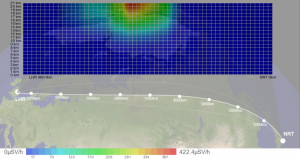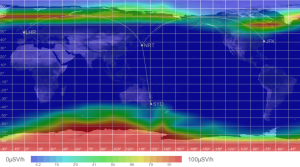Tatsuhiko Sato (Japan Atomic Energy Agency)
Large solar flares and coronal mass ejections occasionally generate solar energetic particles (SEP) that can penetrate through the terrestrial magnetosphere. When high-energy SEP are incident on the atmosphere, they induce extensive air-shower (EAS) by producing various secondary particles, such as neutrons, and increase the count rates of neutron monitors (NM) at the ground level. This phenomenon is called ground level enhancement (GLE). Moreover, the radiation doses are increased during GLE, especially at flight altitudes, and they can be a potential hazard to aircrews and passenger. Thus, development of a system for nowcasting and/or forecasting radiation doses due to SEP exposure is one of the most important challenges in space weather research. Collaboration with other research fields such as nuclear physics and radiological protection is the key issue in such development.
Under the framework of PSTEP, we are therefore developing a physics-based model for SEP dose estimation anywhere in the atmosphere and designated it WASAVIES: WArning System for AVIation Exposure to Solar energetic particles. Recently, WASAVIES was improved to be capable of real-time and automatic analysis. In the improved system, the count rates of several neutron monitors (NM) at the ground level, as well as the proton fluxes measured by the GOES satellite are continuously downloaded at intervals of 5 min and used for checking the occurrence of GLE. When a GLE event is detected, the system automatically determines the model parameters for characterizing the profiles of each GLE event, and nowcasts and forecasts the radiation dose rates all over the world up to 24 h after the flare onset.
The performance of WASAVIES is examined by analyzing the four major GLE events of the 21st century. The accuracy of the nowcast data obtained by the model is well validated by the reproducibility of the current NM count rates and GOES proton fluxes as well as the flight-dose measurements. Figures 1 and 2 show the worldwide dose rate map at 12 km and route-dose rate map between Tokyo and London, respectively, during GLE 69 (7:00 UT, Jan 20, 2005) drawn using WASAVIES. The complicated latitude, longitude, and altitude dependences of the dose rates such as the southern asymmetry can be seen in these figures, owing to the sophisticated physics models implemented in WASAVIES.
The details of the calculation procedures of WASAVIES together with its validation results are given in Ref. [1]. In addition, we applied WASAVIES to the post evaluation of the SEP dose rates during GLE 72, which occurred in Sep. 2017 [2]. Our calculation suggested that the maximum SEP dose rate at a flight altitude of 12 km during the event was approximately 3 μSv/h, which is less than half of the dose rate due to galactic cosmic rays. A web-interface of WASAVIES is currently under development, and it will be released in the near future through the public server of NICT.
References
[1] T. Sato, R. Kataoka, D. Shiota, Y. Kubo, M. Ishii, H. Yasuda, S. Miyake, I.C. Park, and Y. Miyoshi, Real-Time and Automatic Analysis Program for WASAVIES: Warning System for Aviation Exposure to Solar Energetic Particles, Space Weather, 16 (2018) DOI: 10.1029/2018SW001873
[2] R. Kataoka, T. Sato, S. Miyake, D. Shiota, Y. Kubo, Radiation Dose Nowcast for the Ground Level Enhancement on 10-11 September 2017, Space Weather, 16 (2018) DOI: 10.1029/2018SW001874

Figure 1. Worldwide map of calculated dose rate at 12 km during GLE69 (7:00 UT, Jan. 20, 2005) drawn using WASAVIES

Figure 2. Contour map of calculated dose rates over a typical flight route between Tokyo and London during GLE69 (7:00 UT, Jan. 20, 2005) drawn using WASAVIES
